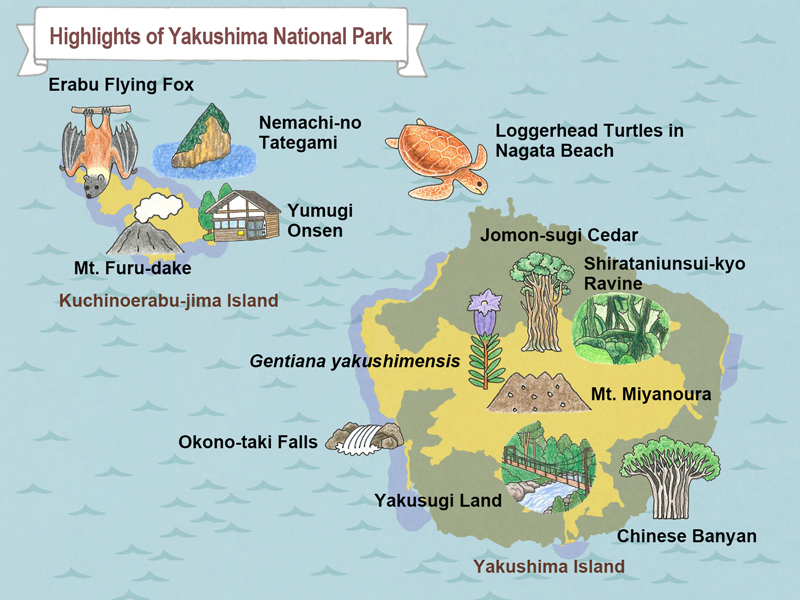- MOE
- National Parks of Japan
- Yakushima (Island) National Park
- Guide of Highlights
main body
Highlights of Yakushima National Park
Yakushima Island
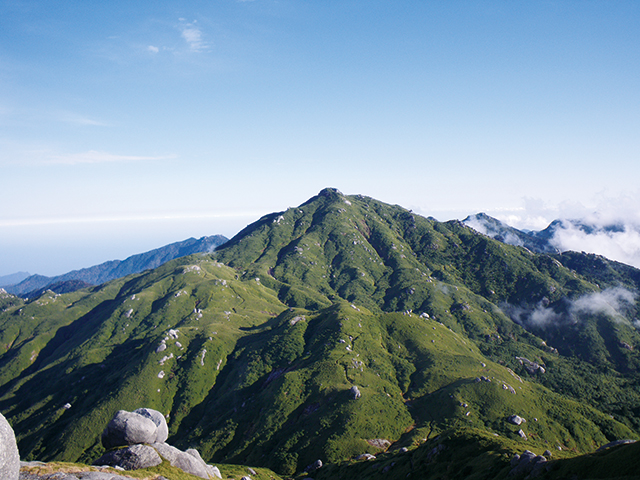
Mt. Miyanoura
Yakushima Island
The most attractive feature of Yakushima Island is the mountains. There are over 39 mountains with peaks higher than 1,000 m with Mt. Miyanoura (1936 m above sea level) at the top of the list as the highest mountain in Kyushu. Those mountains include the top eight highest mountains in Kyushu. The mountains that can be seen from villages such as Mt. Mocchomu (940 m above sea level) are almost 1,000 m heigh.Especially in areas over 1,600 m heigh, the flowers of Pieris japonica and Rhododendoron Yakusimanum Nakai blossom and color the landscape from April to June.
There are two other attractive features of the island. One of these is the awesome forest landscapes of giant trees. The unique forests that have nurtured the cedars, like the well-known Jomon-sugi cedar cover the area at elevations around 1,000 m to 1,400 m above sea level. The other feature is that vegetation from both subtropical and cool temperate zones continues to remain; nowhere else in the western area can we see such vegetation distributed vertically between these zones. These two attractive features of Yakushima are recognized as having significant and universal value as World Natural Heritage sites.
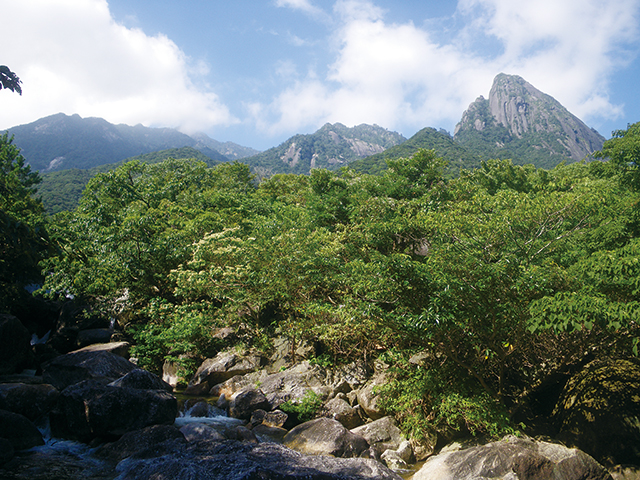
Mt. Mocchomu
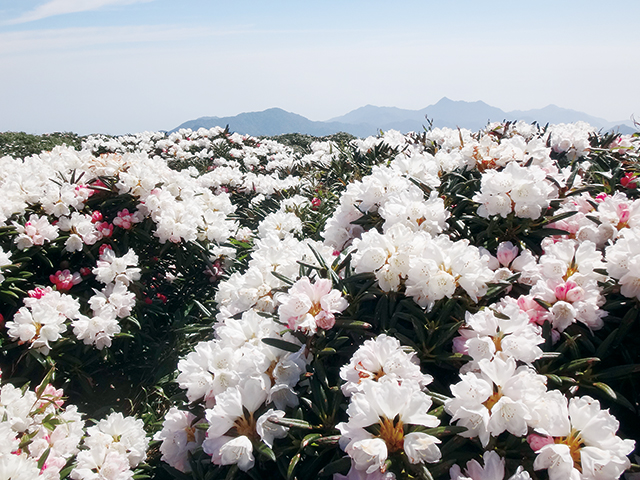
Rhododendoron Yakusimanum Nakai
Mt. Miyanoura

Mt. Miyanoura
The top of the highest peak on Kyushu (1,936 m) provides an expansive 360° view, including the peaks of Yakushima Island. In the areas around the peaks, Pieris japonica and Rhododendron yakushimanum bloom in spring, while in winter, a capping of snow brings a platinum-white world.
Shirataniunsui-kyo Ravine
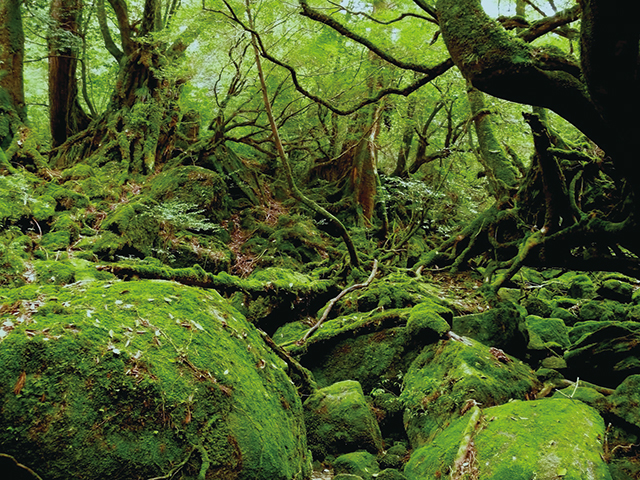
Shirataniunsui-kyo Ravine
Shirataniunsui-kyo Ravine is the area designated Natural Recreation Forests located at an elevation from 600 m to 1,050 m. In the ravine, visitors can see old growth forest covered with moss, see a mountain stream flowing over granite, and stroll in a mixed needleleaf-broadleaf forest of yakusugi and laurel forest.
Yakusugi Land
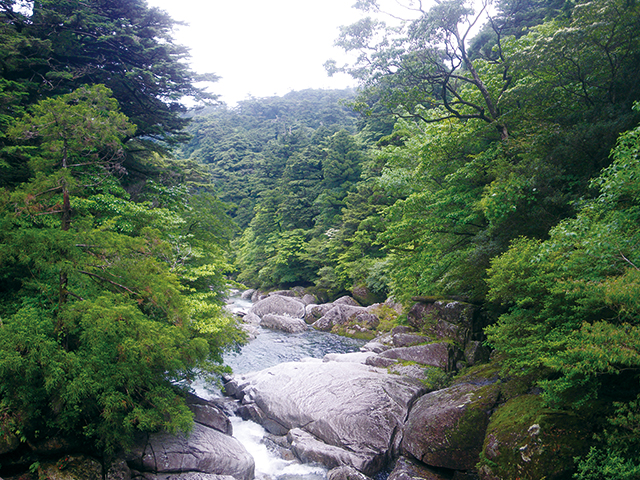
Yakusugi Land
As its name suggests, there are a number of yakusugi on Yakusugi Land. The land is designated a Natural Recreation Forest at an elevation from 1,000 m to 1,300 m Visitors to the land can glimpse old stumps from the ancient work of forestry on Yakushima Island.
Okono-taki Falls
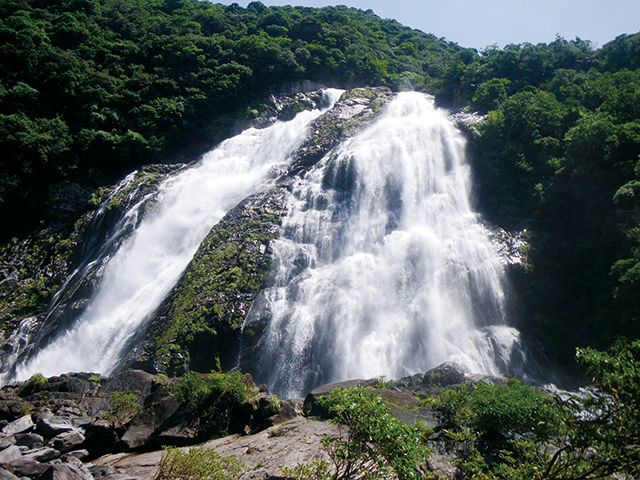
Okono-taki Falls
Okono-taki Falls are grand waterfalls representative of Yakushima Island at a height of 88 m. The attractive feature is the sight that changes just after rain because the rainfall runs over bedrock for a stretch on the island.
Western Area

Western Area
The Western Area is the area where visitors can enter the Natural World Heritage site by car. The area is one of the largest Japanese laurel forests with a number of yakushimazaru (subspecies of Japanese macaque) and yakushika (subspecies of sika deer). The Tunnel of Green is a good site to observe monkeys and deer.
Nagata Beach

Nagata Beach
Nagata Beach is where loggerhead turtles lay eggs in Japan and is listed as a Ramsar Site of the Ramsar Convention. You can overlook Kuchinoerabu-jima Island on the East China Sea from the beach. The beach is the largest sandy beach on Yakushima Island, and visitors can observe sea turtles lay eggs from May to July.
Kuchinoerabu-jima Island
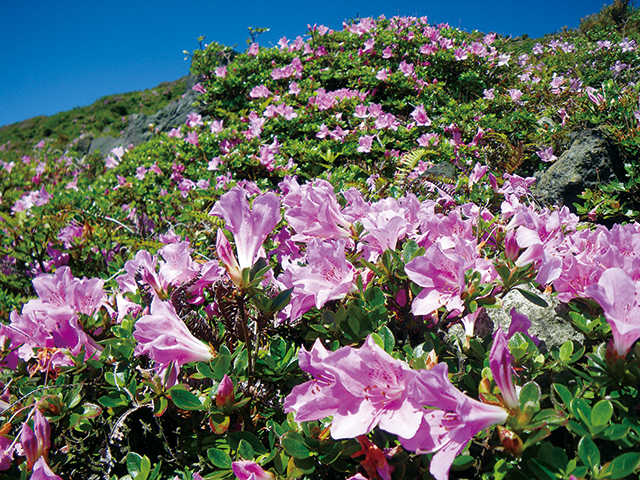
Marubasatsuki (plant species of azalea )
Kuchinoerabu-jima Island
The attractive features of Kuchinoerabu-jima Island are the volcanoes and the sea. The eastern part of the island consists of active volcanoes and volcanic vents with fumaroles emitting volcanic gas, and the vegetation affected by the gas can be seen around the peaks of Mt. Furu-dake.
Especially in June to July, the flowers of marubasatsuki (plant species of azalea) around the peak blossom and color the mountain surface pink. In addition, there are several onsens (hot springs) on the island. It is fun to travel and enjoy the onsens of the Green Volcanic Island, which is covered by laurel forest and bamboo grassland.
On the other hand, the attractive feature of the sea is its beautiful coastal landscapes of natural coasts that remain tide pools and odd-shaped rocks and shallow beaches where you can see subtropical fish and coral colonies.
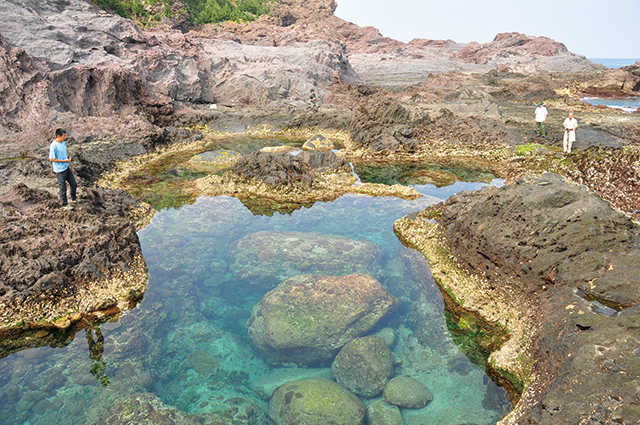
Megasaki Tide Pool
Mt. Furu-dake
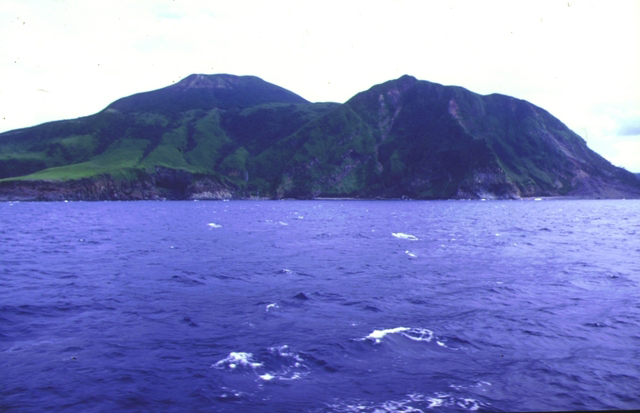
Mt. Furu-dake
Located in the east of Kuchinoerabu-jima Island . Continues to be volcanically active. The dynamic volcanic scenery expands across the vicinity of the peak. Rhododendron eripcarpum blooms in profusion in June and July, covering the mountainsides in pink.
Yakushima Island viewed from the Mt. Furu-dake mountain trail

Yakushima Island viewed from the Mt. Furu-dake mountain trail
On Kuchinoerabu-jima Island, there are landscapes that you could never see on Yakushima Island. Even though the distance between these islands is only 12 km, visitors can experience very different types of nature.
Nemachi-no Tategami

Nemachi-no Tategami
The majority of the shoreline of Kuchinoerabu-jima Island remains in its natural state. Characterized by unique scenery in the form of sea cliffs and cliff caves as typified by the rock referred to as "Nemachi-no Tategami."
Yumugi Onsen

Yumugi Onsen
As for the volcanic island, there are four onsens with a good atmosphere on Kuchinoerabu-jima Island. Yumugi Onsen, which is located in Yumugi Village, is hidden with fluttering yu-no hana (deposits of minerals).
Megasaki Tide Pool
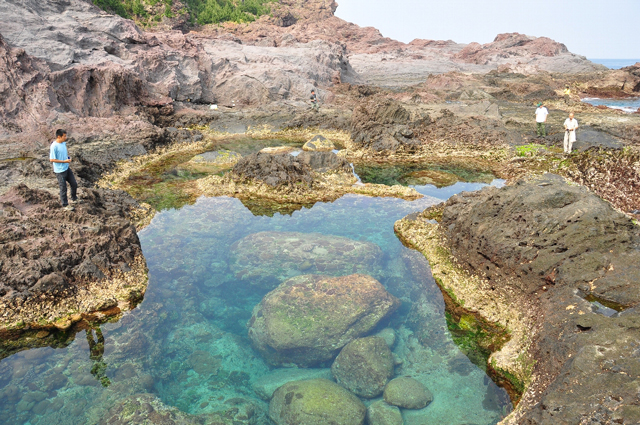
Megasaki Tide Pool
The shallows of Point Megasaki on Kuchinoerabu-jima Island support many coral communities and a wide variety of fish within the beautiful underwater scenery. These can also be seen in the tidal pools.
Activities
Eco Tour of Village

Eco Tour of Village
The attractive feature of Yakushima Island is not only the abundant nature. The local people, on Yakushima Island and Kuchinoerabu-jima Island, are advertising the attractive features of the villages. Join the Eco Tour offered by local guides to experience the history and culture that differ from village to village.

Wildlife & Plants
Jomon-sugi Cedar

Jomon-sugi Cedar
Jomon-sugi cedars is the largest of all the confirmed amongst Yaku cedars aged 1,000 years or more. Various opinions put the age of the trees at between 2,000 and 7,500 years. The stocky shape of the trees is a characteristic of Yaku cedars growing in areas subject to regular typhoons.
Gentiana yakushimensis
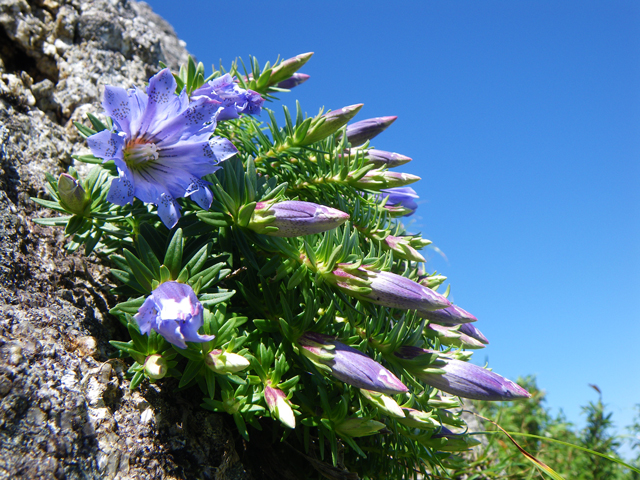
Gentiana yakushimensis
Unique to Yakushima Island. Grow in the rocky areas of high mountains on Yakushima Island. Blooms with a bluish-purple flower in August and September.
Chinese Banyan (Ficus microcarpa)
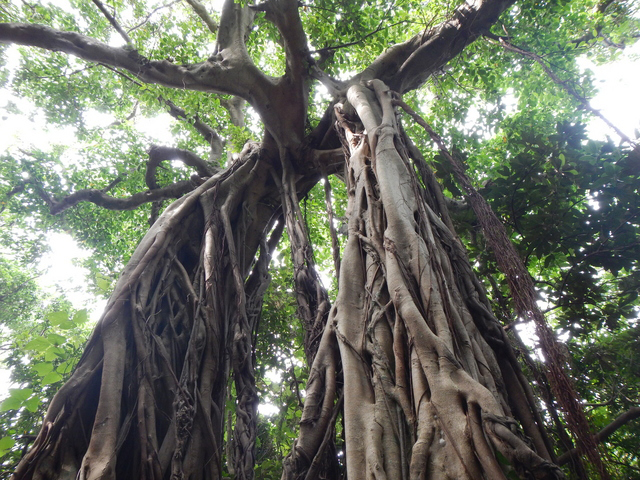
Chinese Banyan (Ficus microcarpa)
A tall evergreen tree, a species of the Moraceae family, distributed over tropical and subtropical zones. Found on Yakushima Island and Tanegashima Island in Kyushu and further south, and primarily in the Ryukyu Islands. Aerial roots hang entwined from the branches. A vivid reminder of the forests of the tropics.
Loggerhead Turtles in Nagata Beach
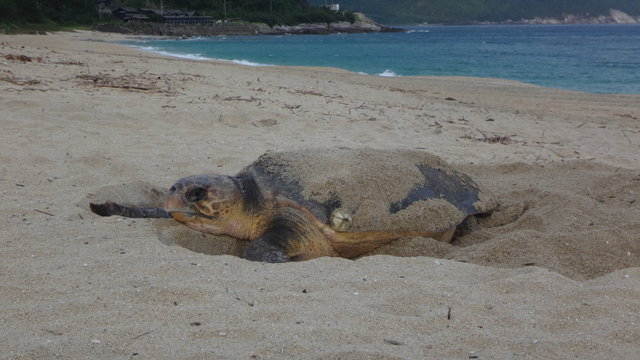
Loggerhead Turtles in Nagata Beach
Nagata Beach on Yakushima Island is the main sand beach in Japan where loggerhead turtles come ashore to lay their eggs. The largest sand beach on the island, it overlooks Kuchinoerabu-jima Island in the east China Sea. The turtles can be seen laying their eggs between May and July.
Erabu Flying Fox (Pteropus dasymallus dasymallus)
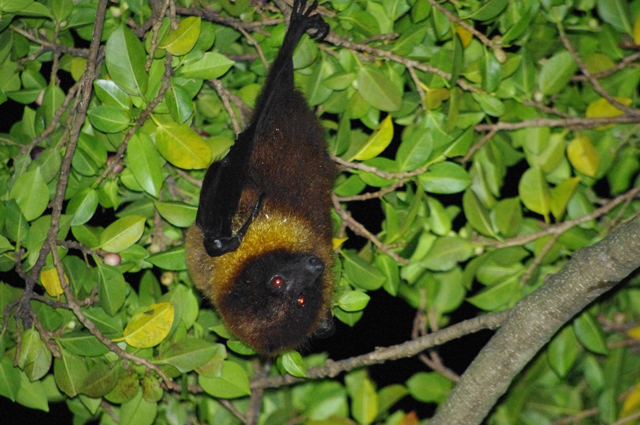
Erabu Flying Fox (Pteropus dasymallus dasymallus)
A subspecies of the flying fox family. Has a wing span of approximately 80 cm. Found only on Kuchinoerabu-jima Island and the Tokara Islands. Designated as a National Natural Monument of the Nation.
